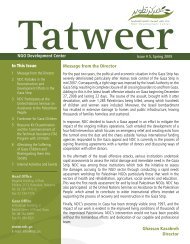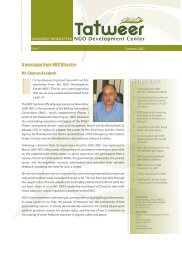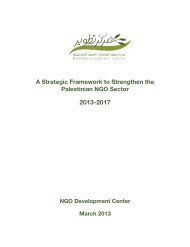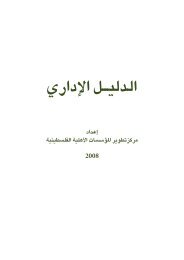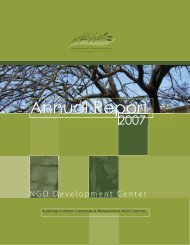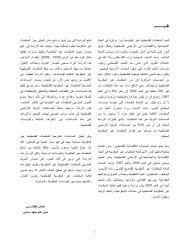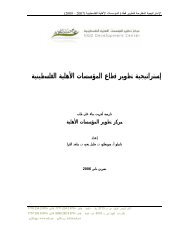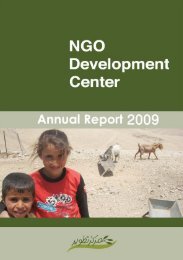Tracking External Donor Funding.pdf - NDC
Tracking External Donor Funding.pdf - NDC
Tracking External Donor Funding.pdf - NDC
Create successful ePaper yourself
Turn your PDF publications into a flip-book with our unique Google optimized e-Paper software.
According to the survey, external funding to large PNGO<br />
projects in Charity and Relief doubles between the first<br />
and second period, as the onset of the Intifada increased<br />
the need for short term assistance. Between 2006 and<br />
2008, charity and relief projects receive just over 18% of<br />
the total external aid to PNGOs.<br />
<strong>External</strong> funding to large PNGOs in the Social Services<br />
Grouping drops steadily over the three periods from<br />
54.7% of total external aid in the first to 32.9% in the<br />
last. The largest part of the social sector grouping is<br />
healthcare, which alone captures 42.2% and 34.4% of<br />
total funding to PNGOs in the first two periods. In the<br />
third period, PNGO projects related to health received<br />
19.8% of total funds. The Palestinian Medical Relief<br />
Society (PMRS), one of the largest Palestinian healthcare<br />
NGOs, declined to take in the survey, leading us to<br />
believe that the percentage of funding captured by the<br />
Health Services sector of the social services grouping<br />
would be even higher.<br />
According to our survey of PNGOs, external aid to<br />
projects included in our Rights-based grouping<br />
decreased slightly between the first and second period,<br />
despite the increased focus on human rights at a time of<br />
crisis. The percentage of aid designated to this grouping<br />
rises between the second and third period, moving from<br />
8.6% to 14.8% of the total, presumably spurred on by the<br />
rapid increase in funding to democracy and good<br />
governance in the 2005 lead up to Palestinian elections.<br />
Figure 43: Distribution of <strong>External</strong> aid to Large PNGOs<br />
by Sector Groupings & Period<br />
60<br />
50<br />
40<br />
30<br />
20<br />
10<br />
0<br />
1999-2000 2000-2005 2006-2008<br />
Charity & Relief<br />
Economic and Others<br />
Rights-based Development<br />
Educational<br />
Social<br />
Source: MAS, 2009 – PNGO Survey<br />
<strong>External</strong> aid to PNGOs engaged in the Group Education<br />
behaved predictably, dropping by more than half during<br />
the Intifada, and recovering once more in the third<br />
period, where it makes up 5.9% of externally funded<br />
PNGO activities.<br />
<strong>Funding</strong> to PNGOs working in sectors that benefit the<br />
Economy rises steadily over the three periods analyzed.<br />
In the first period this grouping captured 14.2% of total<br />
aid to PNGOs, 21% over the second period and 27.9% in<br />
the third - nearly as large as the Social Sector.<br />
3.11.2 <strong>External</strong> <strong>Funding</strong> to Large PNGOs by<br />
Target Area<br />
Though our donor survey returned a more representative<br />
picture of external aid to PNGOs by target population,<br />
our survey of PNGOs captured an interesting picture of<br />
the target populations of the largest PNGOs. Unlike our<br />
20 to 10% between 2006 and 2008.<br />
donor survey however, PNGO respondents were given<br />
the option of choosing ‘All Populations’ to describe<br />
the beneficiaries of large programs spread throughout<br />
target areas. Though the data is more ambiguous,<br />
interesting trends can be identified.<br />
As the following figure 44 shows, large PNGO projects<br />
targeting Urban areas have fallen steadily over the three<br />
periods from around<br />
<strong>External</strong> funding to PNGOs working with Rural<br />
populations carries the largest percentage throughout the<br />
period studied. In the first and second period, the<br />
percentage of aid sits around 43%, dropping only slightly<br />
in the second period in favor of refugees and ‘all<br />
populations’. In the final period, rural populations are<br />
allocated nearly 53% of the total.<br />
59


